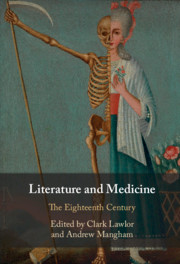Book contents
- Literature and Medicine
- Literature and Medicine
- Copyright page
- Contents
- Figures
- Contributors
- Acknowledgements
- Introduction
- Part I Literary Modes
- Part II Psyche and Soma
- Chapter 4 Mental Illness
- Chapter 5 From Hypo to Bile
- Chapter 6 Metaphors of Infectious Disease in Eighteenth-Century Literature
- Chapter 7 Only Connect
- Part III Professional Identity and Culture
- Index
Chapter 4 - Mental Illness
Locking and Unlocking the Stereotypes
from Part II - Psyche and Soma
Published online by Cambridge University Press: 03 June 2021
- Literature and Medicine
- Literature and Medicine
- Copyright page
- Contents
- Figures
- Contributors
- Acknowledgements
- Introduction
- Part I Literary Modes
- Part II Psyche and Soma
- Chapter 4 Mental Illness
- Chapter 5 From Hypo to Bile
- Chapter 6 Metaphors of Infectious Disease in Eighteenth-Century Literature
- Chapter 7 Only Connect
- Part III Professional Identity and Culture
- Index
Summary
Mental illness is not strictly divisible from physical for much of the long eighteenth century: many mental disorders were thought to originate from physical causes and were treated by similar methods. But this category of disease had an enormous influence on literary productions throughout the period. In the early years, in Swift, for example, and in Pope and in adaptations of Shakespeare, being mad, or eccentric, tended to figure largely, while after the rise of the novel, and of sensibility in particular, the figure of the madman, and especially madwoman, featured prominently as a means of arousing fine feelings, as in Richardson, Sterne, and Henry Mackenzie. Similar currents developed within medicine and psychiatry, not least the movement towards ‘moral management’, taking the mad more seriously, and identifying them as a specialist branch of scientific understanding and treatment. These tendencies reached their height within the Romantic period, with madness being seen by Wordsworth, for example, as one danger of the heightened imagination, but also being valorised, as by Blake, as an exceptionally sensitive and privileged condition. This chapter analyses the major types of mental illness that dominated during the period and the ways in which they were discussed and represented.
- Type
- Chapter
- Information
- Literature and MedicineThe Eighteenth Century, pp. 91 - 112Publisher: Cambridge University PressPrint publication year: 2021
- 1
- Cited by

